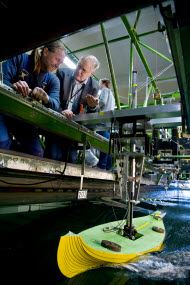
|
|
Photo: Geir Røvik (left), who leads the New Oseberg Ship Foundation, and Per Werenskiold of MARINTEK followed the tests closely for several days. (Photo: Thor Nielsen, SINTEF Media) |
Many theories
The Viking ship, which has been on display at Bygdøy since 1930, was built in 820, buried in a grave mound in 834, reconstructed in 1906-07 after it was found in Tønsberg in the County of Vestfold in 1903, and excavated in 1904.
Some people have suggested that the Oseberg ship was a ritual vessel, since a number of objects on board the find were obviously for ritual use.
Others have wondered whether the ship was designed for inshore sailing, or simply for laying directly on the burial site in the 9th century.
Archaeologists believe that the ship, as it has been restored at Bygdøy, would have dug itself into the sea rather than being lifted by the waves.
Wrongly rebuilt?
These speculations really took off when a full-scale copy of the Oseberg ship was built in 1987 but sank during trials in the Mediterranean.
MARINTEK then entered the scene, and its scientists built a model according to the old drawings, tested it, and found that the vessel did indeed suffer from poor seaworthiness. Tests of the 1:10 scale model showed that when the ship was heeling and making a speed of more than 10 knots, the bow tended to dig itself into the sea instead of lifting.
This confirmation led to a re-evaluation of earlier reconstructions – and people have begun to wonder whether the Bygdøy vessel really does correctly reflect the original design. Could the original ship have been put together wrongly when it was reconstructed in 1904?
Tank-tested
The New Oseberg Ship Foundation (SNOS) is a research project that aims to generate new knowledge about the seaworthiness and sailing capacity of the original vessel. The Foundation has a single clear goal: to built an archaeologically authentic copy of the Oseberg ship.
The new research project, which was a cooperation between The Museum of Cultural History, SNOS and the Viking Ship Museum in Roskilde in Denmark, therefore built a 1:10 reconstruction model of the “New Oseberg Ship”. This formed the basis of the plastic model that was tested in MARINTEK’s Model Tank in order to find out whether the conclusion of a broader forepart and more highly arched keel line was correct.
So far, the conclusion is that the Oseberg ship is more seaworthy than we had believed. Geir Røvik, director of SNOS, and Vibeke Bischoff, from the Viking Ship Museum and head of the reconstruction of the Osebergship, who was present during the model tests, admits that all doubts have been swept aside.
The results of a more detailed comparison of the two vessels will be available in the first week of May.
Contact: Per Werenskiold, MARINTEK
Tel: +47 73 59 58 06, e-mail:
